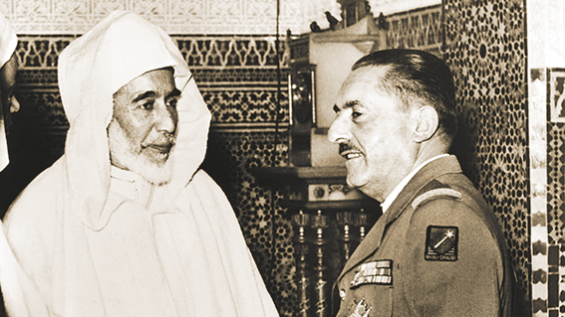When Morocco was under the French protectorate, sultan Mohammed Ben Youssef decided to team up with nationalists, who wanted France out of the country. The French were so worried that they started thinking of a plan B, which considered getting rid of the beloved sultan.
With the help of influential Pasha Thami El Glaoui, the French came up with a plot that included the Sultan’s cousin. At the beginning of the 1950s, the Pasha of Marrakech issued a statement that was signed by 270 Pashas and Caids with the aim of destroying the credibility of the sultan.
According to Moroccan historian Abdelkarim Filali, El Glaoui’s statement sent to French Resident-General in Morocco, demanded the dethroning of sultan Mohammed Ben Youssef. The Pashas accused the sultan of allying himself with nationalists and contradicting the religious values of the country.

The French quickly responded to the demands of Pasha El Glaoui and his allies. «In 1953, France exiled the highly respected Mohammed V and replaced wim with the unpopular Mohammed Ben Aarafa», recalled the book «Morocco Investment and Trade Laws and Regulations Handbook» (Int'l Business Publications, 2008).
The sultan was sent to Corsica, a French island, and Ben Arafa was declared sultan of Morocco on August 21 of the same year. Ben Arafa or the man with the «black Bernous» is the son of Arafa ben Mohamed ben Abderrahman and the nephew of Hassan I, who’s the grandfather of Moulay Mohammed Ben Youssef.
Dethroning Ben Youssef for an unpopular sultan
Despite the endorsement of the French, Ben Arafa was met with backlash for replacing his deposed cousin. «Ben Arafa’s reign was widely perceived as illegitimate and sparked active opposition to the French rule», the same book added.
Indeed, the streets of Morocco were heated and nationalists tried to show their rejection of Ben Arafa in many ways. In September 1953, Ben Arafa survived an assassination attempt orchestrated by nationalist Allal ben Abdallah.
Ben Arafa survived several other assassination attempts, but he couldn’t get along with the street anger. By 1955, the French realized that keeping him as a sultan would be a bad decision. Ben Youssef was restored to the throne and it was time for Ben Arafa to leave Rabat.

On October 1st, «Sidi Mohammed Ben Arafa was deposed and left for Tangier», according to Roger Gruner in his book «Du Maroc traditional au Maroc moderne : le controle civil au Maroc, 1912-1956» (Nouvelles Editions Latines, 1984).
From Tangier to Nice
Ben Arafa’s stay in Tangier was also mentioned by American writer William Seward Burroughs. In fact, Arafa was reportedly going to purchase the house, where Burroughs was staying in Tangier. In a letter he wrote in 1964, Burroughs recalled the «ominous event» that occurred while he was working on his famous novel «Naked Lunch», said professor Oliver Harris and Ian MacFadyen in their book «Naked Lunch @ 50: Anniversary Essays» (SIU Press, 2009).
«Twas the rain-riddled late afternoon of December 13, 1955, at the villa Mouniria Calle Cook. Author Bill Burroughs was writing a letter in his penthouse quarters», Burroughs wrote, reffering to himself in the third person.
«Suddenly a stream of men, some carrying guns, opened Burroughs’ door and looked in. The explanation is that Villa Mouniria is for sale for the ‘Black bernous’, none other than the ex-sultan of Morocco Ben Arafa».
Months later, Ben Arafa was forced to leave the city of Tangier after it lost its international status on October 29, 1956. The dethroned sultan left for Nice and despite efforts made by France to allow Ben Arafa to return to Morocco, King Hassan II refused. However, Ben Arafa's daughters were allowed to remain in the country and in the royal palace.

Ben Arafa died on July 17, 1976, 90, in Nice. King Hassan II rejected his family's proposal to bury him in Morocco. He was buried in France, but ten years later, Hassan II allowed his children to be transfer his grave to Morocco. Mohammed Ben Arafa was transferred to Fez, where he was buried in an unmarked grave at the Bab al-Makina cemetery.





 chargement...
chargement...













